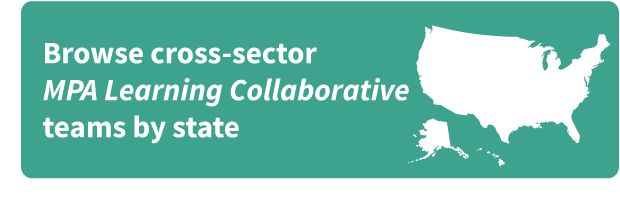As the U.S. population is getting older and increasingly diverse, state leaders and stakeholders are pursuing high-level, cross-sector planning efforts to ensure that the needs of older adults, people with disabilities, and family caregivers are met over the coming decade. A multisector plan for aging (MPA) is an umbrella term for a state-led, multi-year planning process that convenes cross-sector stakeholders to collaboratively address the needs of older adults and people with disabilities. States use a variety of names for these plans (e.g., master plans, strategic plans, and aging-well plans) but all have the same broad goals.
 The Multisector Plan for Aging Learning Collaborative, led by the Center for Health Care Strategies (CHCS), is a learning community that helps states advance their MPAs. Made possible through support from The SCAN Foundation, West Health, and the May & Stanley Smith Charitable Trust, this 12-month collaborative is currently supporting 10 states — Connecticut, Iowa, Maryland, Massachusetts, Missouri, Nevada, New Hampshire, Pennsylvania, Utah, and Washington State — to build on work already underway in their states. Now in its second year, 20 state teams from across the country have participated in this unique cross-sector learning opportunity launched in 2022.
The Multisector Plan for Aging Learning Collaborative, led by the Center for Health Care Strategies (CHCS), is a learning community that helps states advance their MPAs. Made possible through support from The SCAN Foundation, West Health, and the May & Stanley Smith Charitable Trust, this 12-month collaborative is currently supporting 10 states — Connecticut, Iowa, Maryland, Massachusetts, Missouri, Nevada, New Hampshire, Pennsylvania, Utah, and Washington State — to build on work already underway in their states. Now in its second year, 20 state teams from across the country have participated in this unique cross-sector learning opportunity launched in 2022.
To support state success and foster shared learning, the collaborative is providing:
- Peer-to-peer exchange that fosters the sharing of best practices and lessons;
- Access to a network of experts, including those who have helped advance MPAs in other states; and
- Technical assistance on how to build cross-sector buy in and facilitate a collaborative MPA development process.
Cross-agency, cross-sector teams vary by state, with state teams focusing on key phases of the MPA process, including getting started and building buy-in, and developing and implementing an MPA. Learn more about current and past participants.
Advancing Multisector Plans for Aging
MPAs can help ensure coordinated care and support services that enable everyone to age with health, dignity, and connection. CHCS is part of a collective of organizations and funders that are working to mobilize financial, social, and intellectual capital to improve the experience of aging, now and in the future. Learn more at MultisectorPlanForAging.org.
Project Resources





